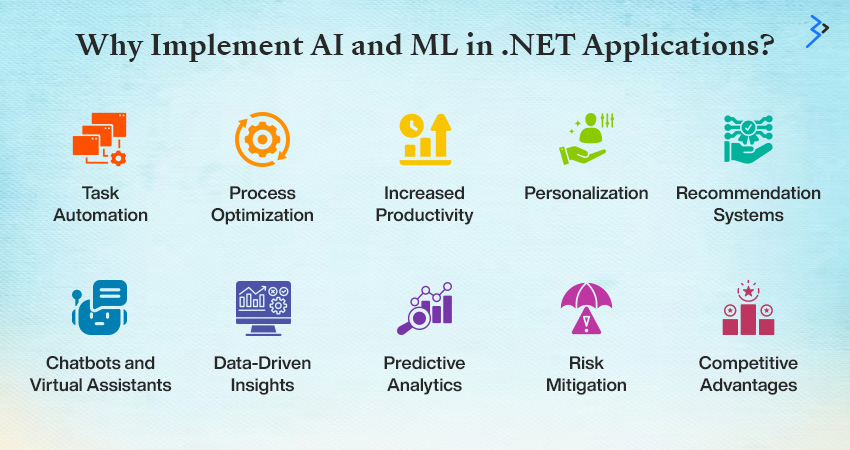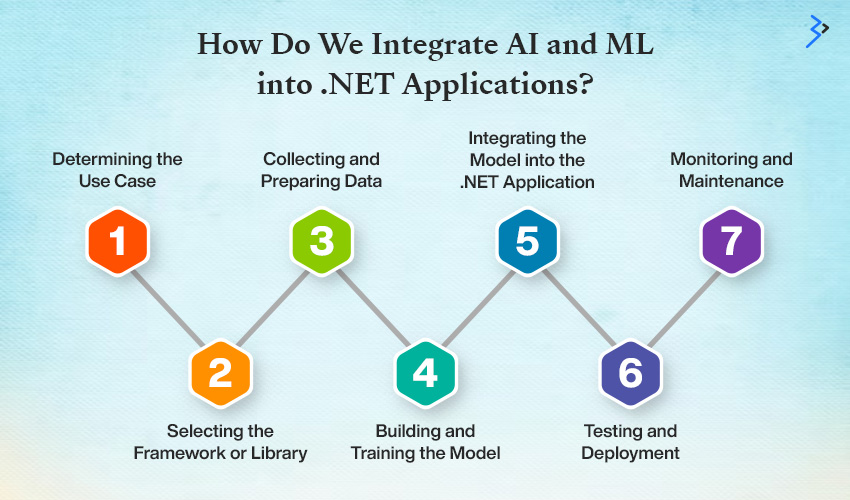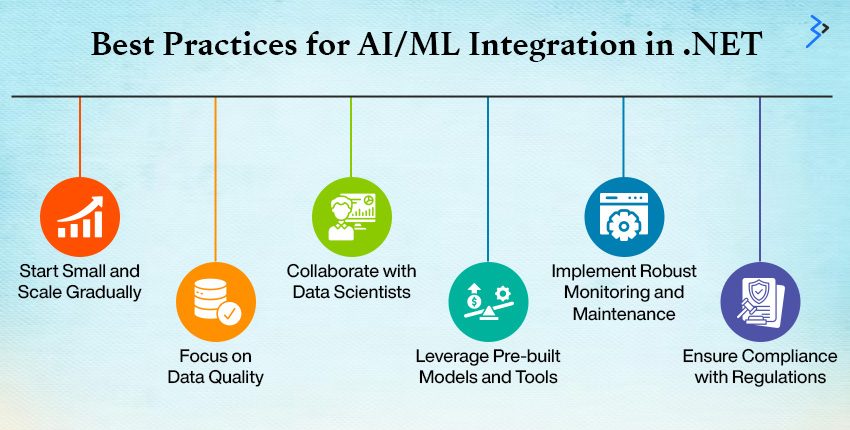Table of contents
Why Implement AI and ML in .NET Applications?
How Do We Integrate AI and ML into .NET Applications?
Prominent .NET Frameworks and AI/ML Libraries
Real-World Use Cases of AI and ML in .NET Applications
Overcoming Challenges in AI/ML Integration with .NET
Best Practices for AI/ML Integration in .NET
Let’s Sneak a Peek into the Future Trends of AI, ML, and .NET
Final Thoughts!
In recent years, Artificial Intelligence (AI) and Machine Learning (ML) have transcended from buzzwords to integral components of modern software development. These technologies are no longer confined to research labs or high-tech industries; they are now accessible to businesses of all sizes, thanks to frameworks like . NET. Integrating AI and ML into .NET applications offers myriad benefits—from enhancing functionality to driving innovation. But what exactly makes .NET an ideal platform for AI/ML integration?
.NET is a versatile and robust framework that has stood the test of time. With a rich ecosystem of tools, libraries, and community support, .NET provides developers with everything they need to build robust, scalable applications. When combined with AI and ML, .NET can help developers create intelligent, data-driven solutions that meet and exceed user expectations. This blog explores the intricacies of integrating AI and ML into .NET applications, offering a step-by-step guide for developers looking to leverage these technologies.

Why Implement AI and ML in .NET Applications?
Integrating AI and ML into .NET applications is not just a trend—it’s necessary for businesses looking to stay competitive in today’s fast-paced digital world. AI and ML offer unparalleled opportunities to improve efficiency, enhance customer experiences, and drive innovation. Here are some key reasons why integrating these technologies into your .NET applications is a game-changer.
Improved Efficiency and Automation
- Task Automation
Automation is one of the most significant benefits of AI and ML. Businesses can free up valuable human resources to focus on more strategic initiatives by automating repetitive tasks. For example, AI-powered bots can handle customer inquiries, process orders, and even perform data entry tasks, reducing the need for manual intervention.
- Process Optimization
AI and ML algorithms can analyze vast amounts of data to identify inefficiencies in business processes. This allows organizations to optimize workflows, reduce waste, and improve productivity. In a .NET application, integrating AI-driven process optimization tools can lead to faster, more efficient operations.
- Increased Productivity
AI and ML can significantly boost productivity by automating tasks and optimizing processes. Employees can focus on higher-value tasks while AI handles routine operations. This increases output and enhances job satisfaction as employees are freed from monotonous tasks.
Enhanced Customer Experience
- Personalization
In today’s digital landscape, personalization is critical to enhancing customer experience. AI and ML can analyze user behavior and preferences to deliver personalized content, recommendations, and services. For instance, a .NET-based eCommerce platform can use AI to recommend products based on a user’s browsing history, leading to higher conversion rates.
- Recommendation Systems
AI-powered recommendation systems are essential for businesses looking to offer relevant and timely suggestions to their customers. By integrating ML algorithms into a .NET application, companies can create recommendation engines that analyze user data to suggest products, services, or content that align with their interests.
- Chatbots and Virtual Assistants
Chatbots and virtual assistants powered by AI are revolutionizing customer support. These intelligent agents can handle customer interactions, from answering FAQs to processing transactions. By integrating AI-driven chatbots into .NET applications, businesses can provide instant, 24/7 support, improving customer satisfaction and reducing operational costs.
Enhanced Decision Making
- Data-Driven Insights
AI and ML are invaluable tools for extracting actionable insights from data. By integrating these technologies into .NET applications, businesses can analyze data in real-time to make informed decisions. Whether identifying market trends, predicting customer behavior, or optimizing supply chains, AI-driven insights can give businesses a competitive edge.
- Predictive Analytics
Predictive analytics is one of the most powerful applications of AI and ML. By analyzing historical data, AI algorithms can predict future outcomes, allowing businesses to address potential challenges proactively. Integrating predictive analytics in a .NET application can help companies to forecast demand, manage risks, and optimize resource allocation.
- Risk Mitigation
AI and ML can also play a crucial role in risk management. These technologies can analyze data patterns to identify potential risks and suggest mitigation strategies. For example, AI-driven fraud detection systems in a. NET-based financial application can detect suspicious activities and prevent fraudulent transactions.
Competitive Advantages
- Innovation
Innovation is the lifeblood of any successful business. By integrating AI and ML into .NET applications, companies can develop innovative solutions that set them apart. Whether creating new products, enhancing existing services, or improving operational efficiency, AI-driven innovation can drive business growth.
- Market Differentiation
Differentiation is vital to success in a crowded market. AI and ML can help businesses stand out by offering unique features and capabilities that competitors may need to improve. For example, a .NET-based application with advanced AI-driven features can attract more customers and retain them longer.
- Increased Revenue
Ultimately, integrating AI and ML into .NET applications aims to drive revenue growth. By improving efficiency, enhancing customer experience, and enabling innovation, these technologies can help businesses increase sales, reduce costs, and improve profitability.

How Do We Integrate AI and ML into .NET Applications?
Integrating AI and ML into .NET applications is a multi-step process that requires careful planning and execution. The following sections outline the key steps, from identifying the right use case to deploying and maintaining the application.
Let’s understand the process of integrating AI/ML into .NET apps!
Step 1: Determining the Use Case
The first step in integrating AI and ML into a .NET application is identifying the specific problem or opportunity you want to address. This could be anything from automating a business process to enhancing user experience with personalized recommendations. The key is to focus on a use case that aligns with your business goals and offers measurable benefits.
Step 2: Selecting the Framework or Library
Once you’ve identified the use case, the next step is to select the appropriate AI/ML framework or library. The choice will depend on several factors, including the complexity of the AI/ML model, the amount of data available, and the specific requirements of your .NET application. Some popular options include:
- ML.NET: A machine learning framework explicitly built for .NET developers, offering a wide range of tools for building, training, and deploying ML models.
- TensorFlow.NET: A .NET binding for TensorFlow, ideal for integrating deep learning models into .NET applications.
- Accord.NET: A comprehensive framework for machine learning, computer vision, and statistical analysis, offering various tools and algorithms.
Step 3: Collecting and Preparing Data
Data is the lifeblood of AI and ML. The quality and quantity of data available will directly impact the performance of your AI/ML models. Data collection involves:
- Gathering relevant data from various sources
- Cleaning and preprocessing it
- Preparing it for model training
This step is critical to ensuring that your models are accurate, reliable, and capable of making informed predictions.
Step 4: Building and Training the Model
Once the data is prepared, the next step is to build and train the AI/ML model. This involves selecting the appropriate algorithms, tuning hyperparameters, and iteratively training the model until it achieves the desired level of accuracy. Depending on the complexity of the model, this step can be time-consuming and may require significant computational resources.
Step 5: Integrating the Model into the .NET Application
After training the model, it must be integrated into the .NET application. This involves embedding the model into the application’s codebase, ensuring it can interact with other components, and configuring it to process real-time or batch data. The integration process may require custom code, APIs, or middleware to facilitate seamless communication between the AI/ML model and the application.
Step 6: Testing and Deployment
Before deploying the AI/ML-enhanced .NET application, it’s essential to thoroughly test it to ensure that the integration is successful and that the application performs as expected. This includes testing the AI/ML models for accuracy, reliability, and scalability and ensuring that the application meets performance, security, and usability requirements. Once testing is complete, users can deploy the application to production.
Step 7: Monitoring and Maintenance
AI and ML models are not static; they must be continuously monitored and updated to ensure optimal performance. This involves tracking model accuracy, identifying any drift or degradation in performance, and retraining models as needed. Regular maintenance is essential to keep the AI/ML models and the .NET application in sync with evolving business needs and technological advancements.
Prominent .NET Frameworks and AI/ML Libraries
The .NET ecosystem offers various frameworks and libraries that make integrating AI and ML into applications easier. Below, we explore some of the most prominent .NET frameworks and AI/ML libraries that developers can leverage to build intelligent, data-driven solutions.
.NET Frameworks
.NET Framework
The .NET Framework is a mature and stable platform that has been used for decades to build Windows applications. It offers many tools, libraries, and services, making it an excellent choice for integrating AI and ML into legacy applications.
.NET Core
.NET Core is an open-source, cross-platform framework that allows developers to build applications that run on Windows, Linux, and macOS. Its modular architecture and performance improvements make it an ideal choice for modern applications that require AI/ML capabilities.
ASP.NET Core
ASP.NET Core is a framework for building web applications and APIs. With its support for modern web standards and cloud-native development, ASP.NET Core is a powerful tool for integrating AI/ML models into web-based applications.
AI/ML Libraries
ML.NET
ML.NET is a machine learning framework specifically designed for .NET developers. It provides a simple and intuitive API for building, training, and deploying machine learning models. ML.NET supports various algorithms, including regression, classification, clustering, and recommendation, making AI/ML integration versatile.
TensorFlow.NET
TensorFlow.NET is a .NET binding for TensorFlow, one of the world’s most popular machine-learning frameworks. TensorFlow.NET allows developers to leverage TensorFlow’s powerful deep learning capabilities within .NET applications. It supports many neural network architectures, including convolutional neural networks (CNNs) and recurrent neural networks (RNNs).
Accord.NET
Accord.NET is a comprehensive framework for machine learning, computer vision, and statistical analysis. It offers rich tools and algorithms for building AI/ML models, including regression, classification, clustering, and dimensionality reduction support. Accord.NET is particularly well-suited for applications that require advanced statistical analysis or image processing capabilities.
ONNX Runtime
ONNX Runtime is a cross-platform, high-performance scoring engine for Open Neural Network Exchange (ONNX) models. ONNX is an open-source format for representing AI models, and ONNX Runtime allows developers to run these models within .NET applications. ONNX Runtime is optimized for performance and supports a wide range of hardware accelerators, making it an ideal choice for deploying AI models in production environments.
SciSharp STACK
The SciSharp STACK is a collection of .NET libraries that provide tools for scientific computing, data analysis, and machine learning. The stack includes libraries like NumSharp (for numerical computing), TensorFlow.NET (for deep learning), and Keras.NET (for high-level neural network APIs). It is a powerful toolkit for developers looking to build AI/ML models using familiar .NET syntax.
Real-World Use Cases of AI and ML in .NET Applications
Healthcare
- Predictive Analytics for Patient Care - AI and ML can predict patient outcomes in the healthcare sector based on historical data. For example, a .NET application integrated with ML algorithms can analyze patient records to predict the likelihood of readmission, enabling healthcare providers to take proactive measures to prevent it.
- Medical Imaging and Diagnostics - AI-driven image recognition models can assist in diagnosing medical conditions by analyzing radiology images. A .NET application using TensorFlow.NET can process and interpret X-rays, MRIs, or CT scans to detect anomalies, such as tumors or fractures, with high accuracy.
Finance
- Fraud Detection - Financial institutions can leverage AI and ML to detect fraudulent activities in real-time. A .NET application integrated with ML.NET can analyze transaction patterns and flag suspicious behavior, helping to prevent fraud and reduce financial losses.
- Algorithmic Trading - AI-powered algorithms can analyze market data to make informed trading decisions. Financial firms can automate trading strategies and optimize portfolio management based on predictive analytics by integrating ML models into a .NET-based trading platform.
Retail
- Personalized Shopping Experience - AI and ML can personalize customers’ shopping experiences in the retail industry. A .NET eCommerce application with AI-driven recommendation systems can suggest products based on user behavior, increasing customer engagement and sales.
- Inventory Management - AI and ML can also optimize inventory management by predicting demand and automating stock replenishment. A .NET application integrated with predictive analytics can help retailers maintain optimal inventory levels, reducing the risk of stockouts or overstocking.
Manufacturing
- Predictive Maintenance - In manufacturing, AI and machine learning may identify equipment faults before they happen, allowing for prompt maintenance and lowering downtime. A .NET application with AI-powered predictive maintenance algorithms may analyze machine sensor data to detect future problems and schedule repairs.
- Quality Control - AI-powered computer vision models can control quality in manufacturing processes. A .NET application integrated with Accord.NET can analyze product images to detect defects, ensuring that only high-quality items reach customers.
Customer Service
- Chatbots and Virtual Assistants - In customer service, AI-powered chatbots and virtual assistants can handle customer inquiries, process orders, and provide support around the clock. A .NET application integrated with AI-driven chatbot frameworks can improve customer satisfaction by offering instant, accurate responses.
- Sentiment Analysis - AI and ML can also analyze customer feedback to gauge sentiment and identify areas for improvement. A .NET application with AI-driven sentiment analysis tools can analyze reviews, social media posts, and customer surveys to provide insights into customer satisfaction.
Overcoming Challenges in AI/ML Integration with .NET
- Data Privacy and Security: One of the primary challenges in integrating AI and ML into .NET applications is ensuring data privacy and security. AI/ML models often require access to sensitive data, such as customer information or financial records. Developers must implement robust security measures to protect this data, including encryption, access controls, and secure data storage.
- Model Interpretability: Another challenge is ensuring that AI/ML models are interpretable and transparent. Complex models like deep learning networks can be challenging to understand and explain. Developers should strive to build models that are not only accurate but also interpretable, allowing users to know how decisions are made.
- Scalability: As AI and ML models are deployed in production, scalability becomes critical. Developers must ensure their .NET applications can handle large volumes of data and high traffic levels without compromising performance. This may involve optimizing models, using distributed computing frameworks, or leveraging cloud-based services.
- Continuous Learning and Model Updates: AI and ML models are not static; they must be continuously updated and retrained to remain accurate and relevant. Developers must implement processes for monitoring model performance, detecting drift, and retraining models as needed. This requires automated tools and human oversight to ensure that models continue to perform well over time.
- Integration Complexity: Integrating AI and ML into existing .NET applications can be complex, mainly when dealing with legacy systems. Developers must carefully plan the integration process to minimize disruption and ensure that the AI/ML models work seamlessly with the existing codebase. This may involve refactoring code, creating custom APIs, or using middleware to facilitate communication between components.

Best Practices for AI/ML Integration in .NET
- Start Small and Scale Gradually
When integrating AI and ML into .NET applications, it is essential to start small and scale gradually. Begin with a pilot project or a single use case to test the integration’s feasibility and effectiveness. Once the initial project is successful, you can expand the integration to other application areas.
- Focus on Data Quality
Data quality is critical to the success of AI and ML models. Ensure that the data used for training and inference is clean, accurate, and relevant. Invest in data cleaning and preprocessing tools and implement ongoing data quality monitoring processes.
- Collaborate with Data Scientists
AI and ML integration requires software engineering and data science expertise. Collaborate with data scientists to ensure the models are well-designed, accurately trained, and integrated into the .NET application. This collaboration is critical to achieving the best results.
- Leverage Pre-built Models and Tools
Many AI/ML frameworks and libraries, such as ML.NET and TensorFlow.NET, offer pre-built models and tools to accelerate the integration process. Leverage these resources to save time and reduce complexity. If a pre-built model meets your needs, building one from scratch is unnecessary.
- Implement Robust Monitoring and Maintenance
AI and ML models require ongoing monitoring and maintenance to ensure optimal performance. Implement tools and processes for tracking model accuracy, detecting drift, and updating models as needed. Regular maintenance is essential to keep the models and the application aligned with business goals.
- Ensure Compliance with Regulations
AI and ML applications are subject to various regulations, particularly in industries such as healthcare and finance. Ensure your .NET application complies with all relevant laws and regulations, including data privacy, security, and ethical guidelines. This may involve implementing additional controls, conducting audits, or working with legal experts.
Let’s Sneak a Peek into the Future Trends of AI, ML, and .NET
AI-Driven Development
One of the emerging trends in software development is using AI to assist in the development process itself. AI-driven development tools such as AI code generators can help developers write code, debug applications, and optimize performance. As AI-driven development tools become more sophisticated, they will likely be integrated into the .NET ecosystem, making it easier for developers to build intelligent applications.
Edge AI
Edge AI is deploying AI models on edge devices, such as smartphones, IoT devices, or embedded systems, rather than in the cloud. This trend is gaining momentum as businesses seek to reduce latency, improve security, and enable real-time processing. .NET developers will increasingly need to integrate AI models into edge devices, creating new opportunities and challenges.
AI Ethics and Governance
As AI becomes more pervasive, there is growing concern about its ethical implications. Issues such as bias, transparency, and accountability are becoming increasingly important. Developers must incorporate ethical considerations into their AI/ML models and ensure their .NET applications adhere to ethical guidelines and governance frameworks.
AI-Augmented Reality (AR) and Virtual Reality (VR)
AI is crucial in enhancing AR and VR experiences. Integrating AI-driven features like object recognition, natural language processing, and predictive analytics, .NET developers can create more immersive and interactive AR/VR applications. This trend is expected to grow as AR and VR technologies become more widespread.
Quantum Computing and AI
Quantum computing has the potential to revolutionize AI by solving complex problems that are currently beyond the reach of classical computers. While quantum computing is still in its early stages, it is expected to impact AI and ML significantly in the coming years. The field of applied quantum computing is gaining momentum, focusing on real-world use cases where quantum algorithms can enhance AI efficiency and problem-solving. .NET developers may eventually need to adapt their applications to leverage quantum computing capabilities, opening up new possibilities for AI-driven solutions.
Final Thoughts!
Integrating AI and ML with .NET applications offers immense potential for creating intelligent, data-driven solutions that can transform industries and enhance user experiences. By leveraging the powerful tools and frameworks in the .NET ecosystem, developers can build robust AI/ML applications that drive innovation and deliver tangible business value.
However, integrating AI/ML into .NET applications is challenging. Developers must navigate data privacy, model interpretability, scalability, and continuous learning issues. By following best practices, collaborating with data scientists, and staying informed about emerging trends, developers can overcome these challenges and unlock the full potential of AI/ML in their .NET applications.
As AI and ML technologies evolve, so will the opportunities and challenges they present. By staying ahead of the curve and embracing the latest advancements, .NET developers can ensure that their applications remain at the forefront of innovation in the AI/ML landscape. The future of AI, ML, and .NET is bright, and the possibilities are endless.
Related Articles
Digital Transformation
Hyper-Personalized Banking: Driving Customer Loyalty and Engagement with AI-Powered Adobe Experiences
Digital Transformation
Leveraging 3rd Party LLMs: A Guide to Commercial AI Platforms
Digital Transformation
AI-Driven Security: Protecting Your eCommerce App and Customer Data in an Evolving Threat Landscape


